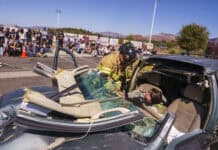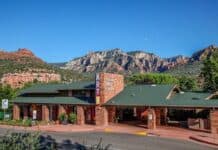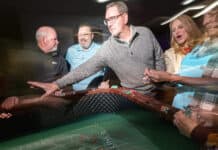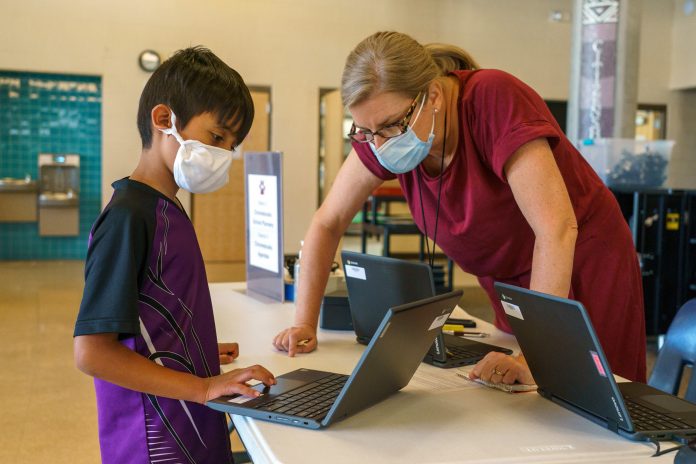
Aug. 19 Update: The Sedona-Oak Creek School District Governing Board held a special board meeting on Aug. 18 where they voted 4-1 to re-open the school for those who choose in a hybrid model on Monday, Aug. 24.
Even though public and charter schools in Sedona reopened online for preschool through 12th graders on Aug. 5, the in-person start date is still up in the air.
Originally planned for Monday, Aug. 17, the Sedona-Oak Creek School District Governing Board voted 5-0 during a meeting on Tuesday, Aug. 11, to push that date back.
Instead of a specific reopening date, the board voted to align with the Arizona Department of Health Services and re-evaluate opening when Yavapai County reaches all three school benchmarks laid out by the health department in its recently launched schools dashboard.
The schools dashboard gives data per county based on three specific COVID-19 benchmarks.
The data is not up-to-date. A note on azdhs.gov about the timeframe reads, “This dashboard does not look at the past two weeks due to potential lags in data.”
Based on data from July 19 to Aug. 1 — the most recent data posted to the dashboard, even though more relevant data is posted daily — no county in the state of Arizona has met the three benchmarks for reopening. Yavapai County meets two out of the three benchmarks.
Benchmarks Met
- A decline in COVID-19 cases, or less than 100 cases per 100,000 individuals for two consecutive weeks
- Two consecutive weeks with hospital visits for COVID-like illnesses in the region below 10%
Benchmarks Not Met
- Two consecutive weeks with percent positivity below 7%
Dashboard data for a decline in Yavapai County cases shows this benchmark was just met, with 272 positive COVID-19 cases in the county, or 121 cases per 100,000 people on July 5, which decreased on July 12 to 214 cases, or 95 cases per 100,000 people.
On July 19, county cases decreased again to 148 cases, or 66 per 100,000 people. July 26 data shows a further decrease to 102 cases, or 45 per 100,000 people.
As far as Yavapai County reaching two consecutive weeks with hospital visits under 10%, it just made the mark at 9% hospital visits for COVID-like symptoms on July 5, but dropped to just 6.8% for COVID visits by July 12 and slightly decreased on July 19 with 6.6% COVID visits. By July 26, it had decreased to 5.1%.
The county did not meet the benchmark for two consecutive weeks with below 7% positive COVID rates. On July 5, 9.4% of tests were positive, which increased slightly to 9.6% by July 12. July 19 data shows a decrease to 7.8%. On July 26, the positive rate decreased to 6.6%, slightly under the goal of 7%.
If the county stays under 7% when data for the week of Aug. 2 is released on Thursday, Aug. 20, the county would meet this benchmark and hypothetically then be able to open. Based on data on the state website, the county has already met this threshold, but these numbers won’t be posted to the schools dashboard for two weeks.
The main dashboard on ADHS, which is updated daily, showed a 5% positivity rate for Yavapai County as of Aug. 13, indicating that the schools dashboard will reflect a 7%-or-lower rate when released, as well.
From the get-go, the district and SOCSD Superintendent Dennis Dearden, who is also the principal of Sedona Red Rock Jr./Sr. High School, had shown interest in reopening as soon as possible. However, during the Aug. 11 meeting, Dearden backpedaled, telling the board that he thinks they should follow guidelines set out by the ADHS, because neither he nor the other board members are health experts.
Before the vote, Dearden told the board that if they were to rely on ADHS data, they needed to use the ADHS schools dashboard with its older data, as opposed to the more current data that could have some lags.
However, the board could have used the more current data or come up with its own requirements because the guidelines are only recommendations, and are not mandatory.
To that effect, the Camp Verde Unified School District voted to keep its in-person opening date of Monday, Aug. 17.
SOCSD Assistant Superintendent Deana DeWitt wrote in an email to Sedona Red Rock News that she “cannot speak to our board’s consensus for using the ADHS data dashboard.” She added that “Yavapai County superintendents have communicated regularly with Leslie Horton, director of Yavapai County Community Health Services, and she endorses the county data reported on the ADHS dashboard.”
DeWitt did not clarify if Horton meant the up-to-date state dashboard or the out-of-date school dashboard.
Like Yavapai County, Coconino County also passed all of the benchmarks except for “two consecutive weeks under 7% positive COVID tests,” declining from a 10.6% rate on June 5, to 8.9% on July 12, and then jumping again to 9.1% on July 19 and down to 5.5% by July 26.
However, many Coconino County schools, including all in the Flagstaff Unified School District, have already committed to not opening their doors for in-person learning until at least October.
Sedona Charter School also recently pushed its distance learning plan to extend at least until the end of its first quarter, which ends Oct. 8.
“We will be monitoring this information carefully and providing regular updates to our families, Dearden said of relying on the ADHS school dashboard data, in a district news release the day after the meeting. “It is our desire to resume in-person instruction as soon as possible, in the safest way possible.”
When Yavapai County does meet the school benchmarks for reopening, SOCSD will have to hold an emergency board meeting to decide when to reopen, likely the Monday following the Thursday data release, DeWitt said.
Reopening would still not be on a full scale, but would open under a hybrid model with about half of the students going to school in-person and the other half watching their classes virtually at the same time.
While this won’t happen Aug. 17, some students will be returning to school on this date.
Support Services
“By Executive Order, until schools are able to reopen for teacher-led instruction, they must provide in-person support services for those students who need targeted services and support for their Virtual Learning,” the district wrote in the news release.
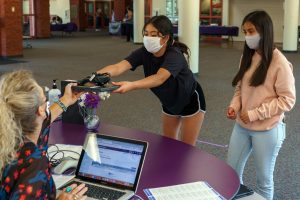
DeWitt said that as of Aug. 12, 29 students from preschool through grade 11 are registered for this. Dearden said that many of them are students with special needs or students whose families selected they will not be able to stay home with their child while they are doing online learning.
Those students will need to be driven to school every day, as the school buses will not be running. They will stay for a full school day, from 8 a.m. to 2 p.m. at SRRHS and 8:45 a.m. to 2:45 p.m. at West Sedona School, much longer than the required 20 to 45 minutes of daily video classes for online learning.
There will be outdoor breaks for the students throughout the day and the schools will be providing them breakfast and lunch. Paraprofessionals, teachers, administrators and special service providers will be supervising them.
“Unless the numbers increase, our plan is to use our cafeteria area at SRRHS and the multipurpose room at WSS to house these students,” DeWitt wrote. “There is ample room for physical distancing and doorways that can be opened to increase fresh airflow. The only exception will be our self-contained Special Education students who will be attending. Their service providers will be working with them in our Special Education classrooms at both schools.”
In addition, a total of 2,500 disposable masks were recently donated to the schools by Clark’s Market and will be available for students, and sanitizer will be available as well.
Update: There will be an Emergency Board Meeting with administrators and the school board on Tuesday, Aug. 18, in order to discuss reopening for partial in-person learning on Monday, Aug. 24.
Alexandra Wittenberg can be reached at 282-7795 ext 126 or at awittenberg@larsonnewspapers.com




